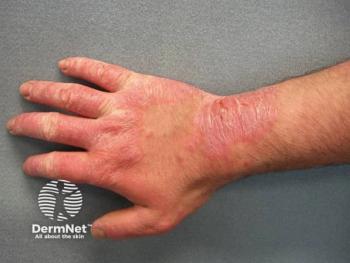
- Dermatology Times, April 2025 (Vol. 46. No. 04)
- Volume 46
- Issue 04
Nonsteroidal Tapinarof Cream Provides Long-Lasting AD Relief
Key Takeaways
- Tapinarof cream 1% provides sustained AD control, allowing treatment-free periods averaging 80 days while maintaining mild disease activity.
- Over 80% of patients achieved clear or almost clear skin, with more than 50% reaching complete disease clearance, highlighting its long-term efficacy.
Tapinarof offers sustained relief for atopic dermatitis, enabling treatment-free periods and long-term disease control—even in young children.
“We need new options. We need nonsteroidal options. We need to simplify the treatment regimen.... I think this is good news, not only for our young pediatric population but also our entire atopic dermatitis population,” Linda Stein Gold, MD, FAAD, said in an interview with Dermatology Times onsite at the 2025 American Academy of Dermatology Annual Meeting. During the interview, Stein Gold, director of dermatology clinical research at Henry Ford Health System in Detroit, Michigan, shared pearls on atopic dermatitis (AD) management, including her recent research with tapinarof cream 1% (Vtama; Organon).1,2
Stein Gold noted that AD presents a significant burden for patients and health care providers because of its chronic, relapsing nature. Traditional topical treatments often provide temporary relief, but symptoms frequently return upon discontinuation. Her recently published research on tapinarof offers promising data on its ability to maintain disease control even after treatment cessation.
Long-Term Efficacy and Treatment-Free Periods
A new analysis from the phase 3 ADORING 3 (NCT05142774) open-label, long-term extension study highlights the sustained effectiveness of tapinarof cream in treating AD in patients aged 2 years and older. The study demonstrated that patients who achieved completely clear skin could maintain a treatment-free period lasting an average of 80 days before requiring retreatment.
“The idea of a treatment-free period is such that with the studies that we looked at with tapinarof and AD, we found that if you get patients with AD to completely clear skin, there was a durable treatment-free period of time, which was 80 consecutive days,” Stein Gold said.
ADORING 3 enrolled 728 patients, including those transitioning from the ADORING 1 (NCT05014568) and ADORING 2 (NCT05032859) trials and treatment-naive pediatric patients. Among the 378 patients who achieved completely clear skin (validated Investigator Global Assessment for AD [vIGA-AD] score of 0), treatment was halted, and their condition was monitored for disease progression. Results showed that, on average, patients maintained mild disease activity throughout the treatment-free interval.
High Rates of Disease Clearance
The study results indicate that tapinarof cream provides significant long-term benefits. More than 80% of patients reached clear or almost clear skin at some point during the study, and more than 50% of patients achieved complete disease clearance. This durability in disease control is a key advantage of tapinarof cream, as many current treatments require continuous application to maintain efficacy.
The study further reported that at the end of the first treatment-free interval, 84% of patients had only mild disease (vIGA-AD score of 2). Additionally, patient-reported peak itch severity remained low, with a mean Peak Pruritus Numerical Rating Scale score of 2.9 and a mean Eczema Area and Severity Index score of 3.4, both indicating mild disease levels.
A Nonsteroidal, Well-Tolerated Option
One of the major challenges in managing AD is the need for nonsteroidal treatment options that are effective yet well tolerated across diverse patient populations. According to Stein Gold, tapinarof cream addresses this need by providing a nonsteroidal alternative that can be applied to any body surface area without restrictions on treatment duration.
“To have a nonsteroidal option that’s well tolerated [and] that we can use on any body surface area for any duration of time, [and] for as much treatment as needed, is really great,” Stein Gold said.
In terms of safety, the most common treatment-emergent adverse events (AEs) observed in the ADORING 3 study included folliculitis (12.1%), nasopharyngitis (6.9%), and upper respiratory tract infection (6.9%). The trial discontinuation rate due to AEs was low at 2.6%, indicating that tapinarof cream is generally well tolerated. AEs such as follicular reactions, contact dermatitis, and headaches were mild or moderate, with minimal associated discontinuations.
Maintenance of Disease Control
Achieving disease clearance and maintaining control over time is crucial for AD management. The ADORING 3 findings demonstrate tapinarof cream’s role in both flare treatment and long-term maintenance.
“We found [that] not only could we get the patients under control, but we could also keep them under control, and we have to have a game plan that really solves both of those issues,” Stein Gold said.
The data support tapinarof cream’s ability to provide sustained relief from AD symptoms, offering patients a treatment that minimizes the need for continuous application while maintaining disease control.
Clinical and Regulatory Significance
The US FDA approved tapinarof cream in December 2024 for treating AD in patients 2 years and older. This followed its initial approval in May 2022 for the treatment of mild, moderate, and severe plaque psoriasis in adults. The new data from ADORING 3 further substantiate its efficacy and safety profile for long-term AD management.
“For patients with [AD], the benefits of many topical treatments are often short-lived, and for some patients, their disease rapidly reappears after taking a break from topical treatments,” said Jonathan Silverberg, MD, PhD, MPH, a principal investigator of the study. “As a physician, I’m encouraged that at the end of a break from treatment with [tapinarof] cream, patients’ AD remained mild. I’m excited to see these data support the use of [tapinarof] cream to potentially provide lasting results for itch, which is the universal and most burdensome symptom of AD.”
Practical Use
The ADORING 3 study reinforces tapinarof cream’s efficacy, demonstrating its ability to provide extended treatment-free periods while maintaining mild disease activity. With more than 80% of patients achieving clear or almost clear skin and a low incidence of AEs, tapinarof cream represents a significant advancement in AD treatment. Its FDA approval for patients as young as 2 years old provides an important nonsteroidal option for both short-term symptom relief and long-term disease management.
References
- New analysis of Organon’s VTAMA (tapinarof) cream, 1% phase 3 data shows atopic dermatitis disease activity remained low after treatment-free interval in adults and children 2 years of age and older. News release. Organon; March 8, 2025. Accessed March 11, 2025.
https://www.organon.com/news/new-analysis-of-organons-vtama-tapinarof-cream-1-phase-3-data-shows-atopic-dermatitis-disease-activity-remained-low-after-treatment-free-interval-in-adults-and-children-2-years-of-ag/ - Silverberg J, Bissonnette R, Stein Gold L, et al. Tapinarof cream 1% once daily: maintenance of low disease activity including pruritus through end of the treatment-free interval in a long-term extension trial in patients down to 2 years of age with atopic dermatitis. Poster presented at: 2025 American Academy of Dermatology Annual Meeting; March 7-11, 2025; Orlando, FL.
Articles in this issue
8 months ago
Dermatology Times April 2025 Print Recap8 months ago
Expert Insights From AAD 20258 months ago
How to Best Support Women With Menopausal AcneNewsletter
Like what you’re reading? Subscribe to Dermatology Times for weekly updates on therapies, innovations, and real-world practice tips.



















